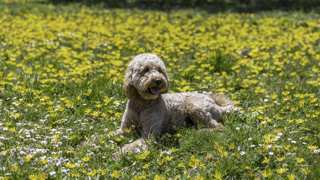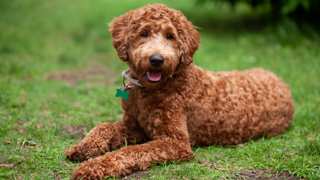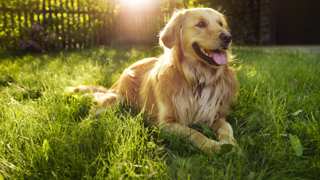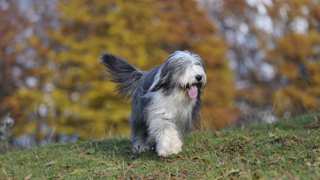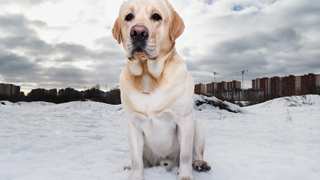Goldendoodles require a good bit more exercise than the average dog. Although the two breeds used to produce a 'Doodle are very different in some ways, both are extremely active dogs that will have offspring who are no less so. There is also size, and this determines the amount of exercise. Two 30-minute walks daily and a weekly dog park visit is the bare minimum. Many Goldendoodle breeders and owners, however, will urge you to do three daily walks and 3-4 weekly dog park visits. Below is detailed information that will help answer, "How much exercise does a Goldendoodle need?"
All 'Doodles need to be kept on a leash when outside the yard or dog park. The smallest Goldendoodles, which can weigh as little as 10-12 pounds, can dart under moving vehicles or become prey to other animals if allowed to run freely. The larger ones, which can be as big as a Standard Poodle and weigh 70-75 pounds, can themselves become a threat to other dogs if not restrained. As puppies, they should not be rigorously exercised until they are about a year old. They should be allowed to build up strength and stamina along with physical maturity. Walks should be done in easy parts with lots of rest and time to relax until these dogs are physically ready for long, uninterrupted sessions. If they are extremely tiny dogs, they tend to get a fair amount of exercise just following you around the house and enjoying some playtime.
Because Goldendoodle size is an important factor regarding what and how much exercise, you should always make sure yours is up for the task. Consulting a vet or breeder is highly recommended so you don't overdo or, just as badly, neglect the amount of exercise. Barking, chewing, digging, aggression, and other bad behavior is very often a sure sign of too little exercise.
Here are some activities and exercise ideas for you and your Goldendoodle:
- Walking: This is good for 'Doodles of all sizes, but the amount and the environment should be adjusted to the dog's size. Here are some suggestions:
- Fetch: Great for the Medium and Standards, but with the Mini, you should be careful and not too rambunctious
- Jogging: Fine for the larger varieties but not for the Miniature Goldendoodle
- Treadmill: Like jogging, this will be good for the two bigger types of 'Doodle, but not recommended for the Minis.
- Swimming: Both parent breeds are historically attuned to being in water, and no matter the size of your Goldendoodle, she'll love it too!
- Agility play: The size and type of toy should be scaled to your dog's size.
- Diving: If you have a dock at a pond or lake, the bigger 'Doodles will love this activity!
There's not much you can do to reduce the amount of Goldendoodle exercise these dogs require. If you think you can't manage enough time to exercise your Golden Retriever Poodle mixed breed, you may want to seriously consider the kind of dog to adopt. As for alternative means to outdoor activities, a treadmill for the two larger types can work so long as they are closely supervised. If you decide to get two or more Mini Goldendoodles, they will always have each other for play. Of course, making sure your Goldendoodle — no matter the size or type — has a proper diet will reduce the amount of exercise needed to get them back into shape too. Regardless, always use playtime for behavior training and reinforcement by way of snacks, controlling the door (when going out for walk), and leading the activity.

